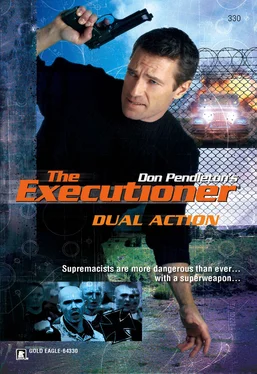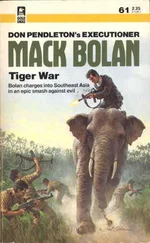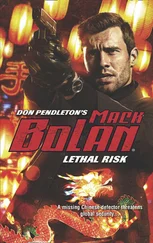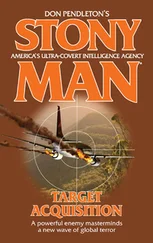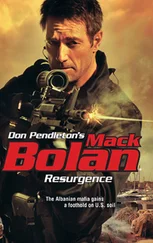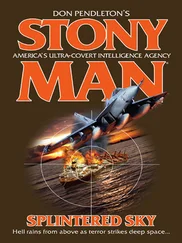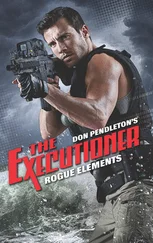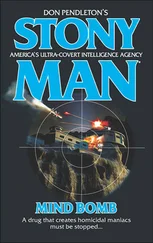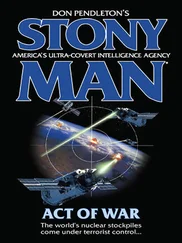There weren’t that many of them. Most had rushed to join their CO at his quarters, or else fanned out to police the camp’s perimeter. Of the dependents in Camp Yahweh, the wives and children of the “Master Race” commandos, Bolan had seen nothing yet and hoped to keep it that way. They were not civilians in the strictest sense, having withdrawn from civilized society to live a racist pipe dream fraught with danger, but he didn’t want them in his line of fire, if it could be avoided.
Wherever they were hiding, none of them emerged as Bolan made his short run toward the gate. He gunned the jeep to its top speed, aimed at the double gates a hundred yards downrange. Two guards were stationed there, and by the time he’d covered half the distance to his target, others were arriving, racing to assist their comrades.
Others still were firing from behind him, peppering the jeep with semiauto fire that struck like ringing hammer blows. A hollow thunk told Bolan that one round had drilled the gas can mounted on the tailgate, but he knew he had fuel enough to get where he was going, and the gunmen would need tracer rounds to set the sloshing gasoline on fire.
Racing across the open camp, he swerved the jeep from side to side, ducking as low as possible while still maintaining visibility across the dashboard. By the time he’d covered fifty yards, the windshield was a pile of pebbled safety glass in Bolan’s lap and strewed around his feet. Sparks flew from glancing bullet strikes, while solid hits drilled through the fenders, flaking paint in perfect circles.
Thirty yards.
The soldiers on the gate were firing at him now, so Bolan aimed his autocarbine through the empty windshield frame and held down the trigger, sweeping its muzzle back and forth in short arcs, left and right. The Colt Commando’s 30-round magazine emptied in less than three seconds, but it lasted long enough to sweep the resistance from the gate and scatter bodies in Bolan’s path. One thumped beneath the tires before the Jeep hit the chain-link gates and powered through.
Behind him, gunfire stuttered on for several seconds, but Bolan quickly killed the headlights and robbed them of their target. It was open country for another hundred yards or so, before he hit tall grass approaching spotty woods. Beyond that point, he had to risk the low beams as he sought a winding path around and through the trees.
Pursuit was possible, since Bolan hadn’t taken time to disable the other vehicles in camp, but it would take some time to organize, and he would see the headlights coming. By the time they found the abandoned jeep, Bolan would’ve found his way on foot back to the rental car he’d stashed a mile due north of Camp Yahweh.
If any of them followed Bolan that far, it would be their last mistake.
He found a place to park, then changed his mind and pushed the vehicle into a ravine with water rippling somewhere near the bottom. There was no point making its retrieval easy on the enemy, he thought. At that point, leaving empty-handed, any inconvenience he could cause was a victory of sorts.
And Bolan wasn’t finished with the Aryan Resistance Movement yet.
CampYahweh hadn’t yielded what he hoped to find, but there were other places he could look, people he could interrogate.
He wasn’t giving up.
The cost of failure was too high, in terms of human lives and suffering.
When Bolan’s job was done, the enemy would know it.
Those, that was, who’d managed to survive.
Two days earlier
A coded-access steel door barred them from the War Room at Stony Man Farm. Barbara Price keyed in her access code, then crossed the threshold as the heavy door slid open. Mack Bolan followed, heard the door shut behind him as he scanned the conference table for familiar faces.
Hal Brognola sat at the head of the table, flanked by Aaron Kurtzman in a wheelchair on his left, two empty chairs immediately on his right for Price and Bolan. Next to Kurtzman, facing one of the empties, sat Huntington Wethers, an African/American cybernetics specialist who’d been lured to the Farm team from a full professorship at Berkeley.
Bolan nodded all around in lieu of handshakes, took his seat and answered the usual small talk about his flight. Even with the chitchat still in progress, he could see Brognola stewing, anxious to be on about the business that had brought them all together.
“We’ve been saddled with a problem,” Brognola began, as if the team had ever been assembled to receive good news.
“I’m listening,” Bolan replied.
“Maybe you heard about the tank incident in Baghdad a few months ago?”
Bolan frowned. “Specifics?”
“An Abrams tank was on routine patrol when it was hit by something that burned through the side skirts and armor on one side, grazed the gunner’s flack jacket and sliced through the back of his seat, then drilled a pencil-sized hole almost two inches deep into the four-inch armor on the turret’s other side. No projectile was recovered. Officially, the incident remains unexplained.”
“And unofficially?” Bolan asked.
“The Pentagon’s as worried as hell. They don’t know what they’re dealing with, who’s got it, how many are out there—in short, they don’t know a damned thing.”
“A secret weapon,” Bolan said. “Each war produces innovations and surprises. Put the SEALs or Special Forces on it. Shake things up. They’ll find a guy who knows a guy and track it down.”
“No luck with that so far,” Kurtzman said. “Top priority or otherwise, they’re pumping dry holes over there.”
“One logical alternative,” Bolan replied, “is a defective weapon of some kind. Guerrillas mix and match. Sometimes they fabricate to meet their needs. New weapons frequently have unpredictable results when they’re first used in combat. Maybe your hotshot was a mistake, and they’ve worked out the bugs.”
“We don’t think so,” Brognola said.
“Why not?”
“Because it’s surfaced in the States.”
Bolan leaned forward in his chair. “Say what?”
“On Wednesday morning, in Ohio,” the big Fed confirmed. “There’s no mistake.”
“Go on.”
“Somebody hit an armored truck en route from Dayton to Columbus, carrying 65 million dollars. Somebody fired twice through the back doors with the supergun—whatever. Cooked the guard back there and spooked the driver, so he rolled it. After that, they used conventional C-4 to pop the doors, iced the witnesses, then made off with the cash.”
“That’s all we have?” Bolan asked.
“Not quite,” Brognola said. “The guards up front got off a radio alarm about the hit. An old gray van, they said, and ‘something weird,’ which pretty much describes the supergun. A couple of state troopers saw the van and started a pursuit.”
“I’m guessing that they didn’t catch it,” Bolan said.
“You’re right. The fugitives lit up a gasoline truck, killed the driver, forced the troopers off the highway, set the fields on fire.”
“The troopers?” Bolan asked.
“One of them’s in a Cincinnati burn ward as we speak. The other didn’t make it.”
“What about the van?”
“Stolen out of St. Louis two weeks earlier,” Brognola said. “Painted and overhauled. They torched it outside Louisville, Kentucky. Wiped out anything forensically significant, but they left stolen license plates from Little Rock, and we could still see how they modified the van inside.”
“Is that significant?” Bolan asked.
“Absolutely,” Wethers interjected. “First, they built a swivel unit where the backseat used to be, then ditched the shotgun seat and fixed the windshield so the right-hand side would lower on a hinge.”
Читать дальше
